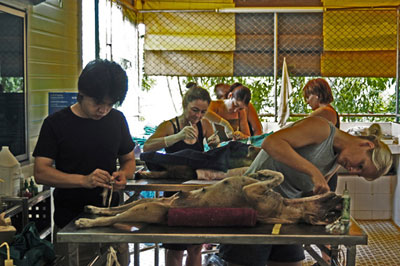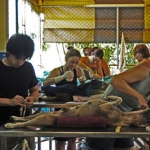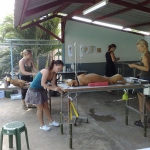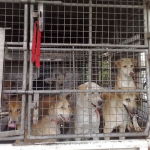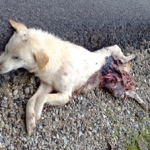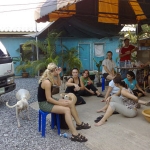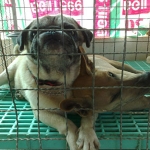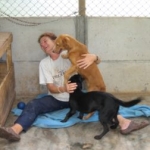Vet in Bangkok on animaltarian work – October/november 2007
By Veterinarian Mogens Østergaard Hansen
The beginning:
Mogens Østergaard Hansen has, during the last seven years been in Asia and Spain seven times to help street dogs and cats.
A short history:
It all began back in 1999 when a client challenged Mogens Østergaard Hansen to collect a group of vets who were interested in helping the street dog problem in the Tibetan part of India. The following year eight vets from Denmark and Sweden under the leadership of Mogens went to the Tibetan exile area in south India. Here they operated on and vaccinated around 200 dogs in very special conditions, for example on Coca Cola cases topped with marble slabs. While they were there they had an audience with the Dalai Lama who praised their initiative and asked if they could start a similar project in Dharasamsala I north India , where the Dalai Lama, himself, lives and where there were Tibetan children dying after being bit by rabid dogs.
The next year the same group went to Dharasamala where they operated on 250 dogs, this time in a wedding tent on the high table with a view to the Himalayas. Since the groups work there has not been a single occasion of rabies in the area and the residents have noticed fewer dogs and that those dogs that remain are in better health than before.
After this contribution Mogens went, alone, to Bodhgaya in east India to investigate the possibilities to send a group of vets there. Bodhgaya is an important place for Bhuddists, it is the place where Buddha was enlightened as he sat under a Bodhi tree. The area has many temples and is and is also the center for western Bhuddists. It was one of these centers that was interested in cooperating with a future project. After a stay in this center, where the only food served to eat was linseed soup, salad and water (a weight loss of 10kg in 14 days!) Mogens arranged for a group of 10 vets together with vets from other countries to take part in a big project. This was a big success and many dogs were operated on.
The following year Mogens was in contact with a street dog organization in Bangkok which needed help. In the last f our years 3 street dog project have been organized in Thailand, all of which have been coordinated and led by Mogens, one of which had 43 people taking part. These people were divided into three teams and worked in eight different areas in Thailand. This was the first time ever that so many vets from a country have taken part in a street dog project.
Over and above this there has been a direct contact from a street dog organization in Barcelona, Spain. Mogens went there in 2007 to help with their cats and at the same time their dogs.
Through these projects thousands of cats and dogs have been operated on, though this seems a small number in relation to the 350 million dogs and at least as many cats hat live without owners throughout the world. But as has been said xThe world wonxt change for one dog, but surely the world would change for that one dog.x Our presence helps to change the attitude towards street dogs and cats in these areas, as the lectures and the publicity in Denmark and other Scandinavian countries create an interest to join and carry out these projects. This is how things spread in water.
In October and November 2007 I was in Bangkok again to work with two organizations SCAD and Dog Chance. The first organization is led by some ex patriots w. ho live in Bangkok, while Dog Chance is led by Pym who is a clever Thai lady. At her home in Bangkok she has around 100 dogs that she looks after, and on her farm between Bangkok and HuaHin she has a further 600 dogs and a further 150 dogs at her clinic close to her farm. All the dogs are street dogs and most of them are suffering from some kind of illness. She also has many crippled dogs the results of traffic accidents where Pym and her many helpers look after and treat their sores everyday which the dogs get from pulling their bodies along on a daily basis. There are also many dogs that are missing one or two of their legs. I have seen dogs without any back legs (or front legs) or missing one front and one back leg. Thank goodness not on the same side, and actually the dogs could run around on two legs. It was surrealistic to look at. One can as a westerner ask why not put these dogs down? But this is not possible choice in Thailand which is a Buddhist country. Here it is thought that dogs have a human soul that has not behaved well in an earlier life. This means that to be a human again one must go through suffering and that it is through this suffering you come closer to a higher consciousness (awareness). So if you kill a dog you take the suffering from him and therefore his soul will not come closer to a higher consciousness. This is the reason there is no medicine to put animals down with at Thailandxs veterinary clinics. On the other hand there is great expertise of amputations.
We were a group of 4 vets and 8 veterinary nurses and several voluntary helpers coming from around Scandinavia and arrive close tong in the middle of October. Actually it was an international group as three of the vets came from respectively from Czech Republic, France and Estonia but had been trained in Denmark and were living there. We met as expected at The Dubliners, an Irish pub in Bangkok together with the two other organizations, to arrange the work. The next day we started. We started at SCAD who had modernized their clinic which was just out of Bangkok and close to Bangkok’s new and modern airport. When I say modernized I do not mean by western standards. They had their cages and operation tables under a permanent roof, previously there had been a felt cloth. But we were still out of doors with a view over a very marshy area as far as the eye could see. One day I went there alone with a taxi the further we went over the small easily flooded roads the more nervous the taxi driver became. Finally he looked nervously at me and pulled his hand across his throat and asked if it was that I had thought of doing to him. I answered I was from the Mafia and that he should just continue driving, and then I smiled.
We operated on many cats which was new for the organization. Before the organization was called Soi Dog Rescue but after they had begun to help with many cats, which are often found around the temples, they had to change their name to SCAD Soi Cat and Dog (soi is the Thai word for street).
The Temples and Tigers:
SCAD works together with the temples in Bangkok and get many cats and dogs from them. Many Thais deliver their cats and dogs to the temples when they can/will no longer have them. Buddhists believe they do good when they do this. I do not think the monks are that pleased with the arrangement as the temples in Thailand have very little money to do “good” with. This means that the monks cannot afford food or treatment of the animal. It was from the temples that we found the very worst of the suffering, starvation and other illnesses. The only temple that really earns money at the moment is the Tiger Temple west of Bangkok. Six years ago I was there was nobody except our little group. There was no travel organization in the whole of Bangkok that knew where it was and it took forever at find the way there. But then it became famous after a series of programs on Animal Planet and sine then there has been no looking back. Today all the travel bureaus advertise with tours to the Tiger Temple together with a tour to The Bridge over the River Kwai which is quite close. Today there are between 4-500 tourists visiting the tigers every day, you are taken around in a group by guides or helpers. It is good economics for the temple as now there is enough money to build a special new tiger area to replace the old one that was collapsing.
After a good operation with SCAD where we operated on 150 cats and 100 dogs we went to Dog Chance. We should be at Pym’s clinic outside Bangkok and down by Hua Hin for two days. Hua Hin is a bathing resort and very popular amongst tourists. In fact many people buy holiday houses or flats there. Pym’s clinic can best be described as a prison. There are 4 concrete walls in the middle of a field with glass shards on the top of every wall. The only opening into the area is a big iron door which is locked when one goes in. Inside there is a very big cage area with 4 cages where there are about 40 – 50 dogs in each cage. There is also 2 sleeping rooms and storage room, eating area and living quarters for the permanently employed (almost imprisoned!). It was here we should be for 2 days operating. When one has stood close to the Himalayas and close to the rain forest and operated it is extremely hard to operate in this environment. But what we missed in views and surroundings was made up for in the enthusiasm and efficiency of the staff. Things really happened with Pym. There are always dogs, she works herself and directs the troops and we were sweating! All of us were really motivated. This was why we were here, to operate and make a difference and not just sit with hands on our laps and drink cocktails. So it was a very happy group of tired people that went back to Bangkok two days later after a mass of work and about 100 operations.
We had a good journey with plenty of experiences and impressions. On this kind of tour where one is involved in work that is either humanitarian or animalterian (new word?!) then you have some experiences that are unknown to the ordinary tourist. I also enjoy being an ordinary tourist to completely relax, so Anne, my wife, and ended the tour with a ten day holiday on a little Thai island. But I cannot forget that feeling that I through my work have the possibility to make a difference without there being any money involved. In fact a large part of the profit from The Veterinary Clinic Holger Danske goes to these projects and thereby my clients are supporting these projects.
There should also be a big thank you to the following firms and people for their support in connection with the carrying out of these projects:
Merial – Tina Heinricy – Oliver’s Foundation
Visit esøg DogChance’s site
Visit SCAD’s site[divider]
- Opstart
- Hundene efter gennemgang af ABC-program.

